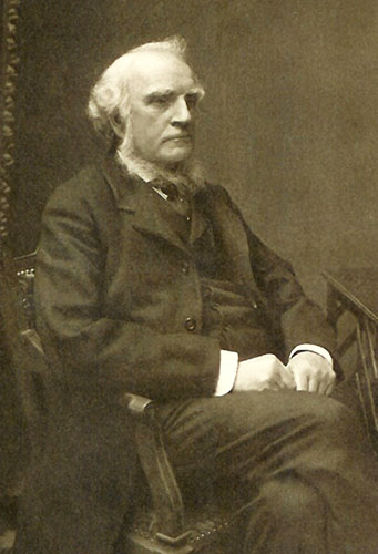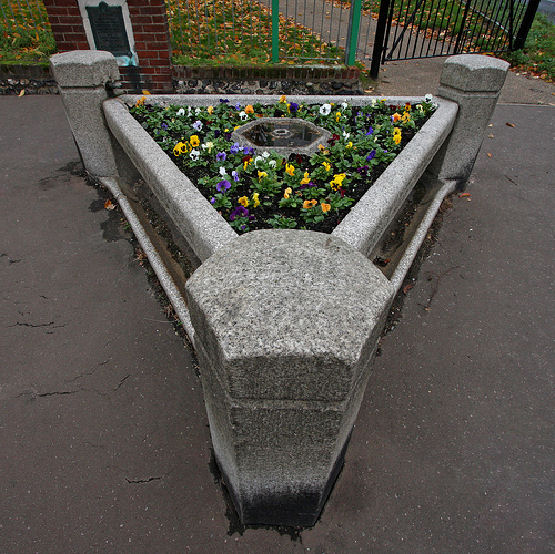

PHILLIP SEWELL'S GIFT
By Tony Storey
This article was originally published in the April 2011 edition of Soul Search, the journal of The Sole Society
Norwich, the County town of Norfolk, is justly famous for its cathedral, its many ancient churches and its association with Lord Nelson, Edith Cavell and of course Anna Sewell, the author of 'Black Beauty'. However, it is Anna's younger brother, Philip, who it might be argued has had the greatest influence on the city.
Philip Edward Sewell was born in Bishopsgate, London in January 1822. His parents, Isaac and Mary, were Quakers, but Philip joined the Church of England in 1840 with the intention of becoming a missionary. For an insight into Philip Edward Sewell as a young man, a letter written by him in 1840 to his sister Anna was published in the April 2003 issue of Soul Search. In 1841 Philip and his sister were living with their parents in North Street, Brighton, Sussex, where Isaac Sewell was the local manager of the London and County Bank.
While at university Philip was advised to follow an outdoor life for the sake of his health so he became an engineer. He assisted in the construction of the London and Brighton Railway and in similar projects.
Philip married Sarah Woods in 1849 and their daughter, Mary Grace, was born in Skipton, Yorkshire in the following year. In 1851 they were living with Philip's uncle, John Wright, at Buxton, Norfolk. Philip's work took the family to Spain, where they stayed for several years until Sarah became ill. In 1864 Philip moved to Clare House, St Clement's Hill, Norwich, finding employment with Gurney's Bank and eventually giving up civil engineering.
When Sarah died at 45 towards the end of 1866 Philip was left to raise his own seven children, as well as being the guardian of a family of seven orphans. Philip's parents had retired to Siston, near Bristol, but in 1867, they and their daughter Anna moved into The White House, Old Catton, Norwich, in order to support their son. Isaac Sewell rented the White House from 1867 until 1878, when the rent was £45 per annum. He had a conservatory built as a summerhouse for his daughter Anna, although it was subsequently demolished and replaced. Now known as Anna Sewell House, 125 Spixworth Road, Norwich, the property is Grade II listed.

Phillip Sewell
Every week Philip would visit his parents and sister Anna at Old Catton, usually in a carriage drawn by his favourite black mare, Bessie, believed to be the inspiration for Anna's famous novel. Anna began writing Black Beauty in 1871 and despite her disability and being ill with consumption, she was able to complete the text, which she sold for forty pounds to Jarrolds, the Norwich printers. The book, which highlights cruelty to horses in mid-Victorian England, was published in November 1877 but by April 1878 Anna Sewell was dead.
Philip had married Charlotte Jane Sole in 1870. Charlotte was born in 1826 in Devonport, where her father was a solicitor. It soon became the custom that during the summer months the grounds in front of Clare House were opened to the local schoolchildren on Thursday afternoons. The Sewells would arrange games and prizes and the children would enjoy a tea party before being taken home. Clare House and what became the Sewell estate formed a wedge between St Clement's Hill and Constitution Hill and was originally known as Wren Park. The area lies to the north of the ancient city of Norwich with the land sloping gently southwards towards the medieval city walls and the River Wensum beyond.
Constitution Hill is the continuation of Magdalen Road, the main street out of the city. Magdalen Gate, forming part of the city walls, was mentioned in 1272 and in 1808 was the last of the city gates to be demolished. At this time the land to the north of the city was largely undeveloped and the area was very rural in character with lanes, trees and meadows. St Clement's Hill was only partially developed with a few substantial houses opposite the grounds of Clare House. Nearby were small terraced houses surrounding a corn grinding windmill.
Philip became a Justice of the Peace, an alderman and a member of the Norfolk Education Committee. He supported the temperance movement, was secretary of the Norwich City Mission and worked on behalf of the Discharged Prisoners' Aid Society. In 1872 he inherited his uncle's estate at Buxton and became manager of the Red House School, a boys' reformatory, and chairman of Buxton Parish Council.
Philip's eldest son, John Wright Sewell, died in 1898 aged 41 and the following year, Philip was widowed for the second time when Charlotte died aged 74. Philip remained a director of Gurney's Bank although it was now amalgamated with Barclays.
Philip Edward Sewell died in February 1906 aged 84 and although he was buried at Buxton, the first part of the funeral service was held at his parish church of Christ Church, New Catton. Philip had been a churchwarden there since 1874 and in 1887 had paid for a clock with an illuminated dial to be fixed below the bell-cote. The south window, dedicated 'in honoured memory of P E Sewell, for 28 years churchwarden of this parish', was unveiled by Bishop Sheepshanks in 1907.
It was Philip's wish that the southern part of his estate, formerly opened to the local children on summer Thursdays, should become a park for the citizens of Norwich. His sisters and the then mayor, Edward Gurney Buxton, worked to bring this about and in 1908 the area now known as Sewell Park was presented to the city. The Sewell family also donated a substantial sum towards the laying out of the grounds. There was good weather for the opening ceremony on 6 July 1908 and it was reported that hundreds of people attended, amongst whom were the Mayor, the Sheriff and local dignitaries. The park was declared open by Miss Margaret Sewell and a metal plaque in the wall records the event with the following words:
Sewell Park. This open space once used and loved by
Philip Edward Sewell is dedicated to his memory and to the use and love of his fellow
citizens by his children and Edward Gurney Buxton.
6 July 1908
Just outside the entrance to the park is a granite memorial, originally in the form of a simple fountain and triangular horse and cattle trough, but now filled with soil and planted with flowers.

Granite Memorial outside Sewell Park, Norwich

Horse Trough outside Sewell Park, Norwich
The horse trough dates from 1917 and bears the inscription:
This fountain was placed here by Ada Sewell
in memory of her aunt Anna Sewell authoress of Black Beauty and of
her sister Edith Sewell, two lovers of animals
As well as a memorial to the life of Philip Sewell, the trees and open spaces of Sewell Park are a reminder of the area's more rural past and provide hints of the designed landscape of the former Sewell estate. The park has commanding views over the city, including the cathedral spire, Norwich Castle and the towers of City Hall, St Peter Mancroft and St Giles.
The northern half of the estate including the Sewell family home was also left to the city of Norwich. Clare House became an Open Air School for city children suffering from respiratory ailments and the barn became their washroom and recreation centre.
During the First World War the people of Catton used the barn to stage a concert for soldiers billeted locally.
In 1929 the Blyth School for Girls (now Sewell Park College) was built and occupied the remainder of the Sewell estate. Clare House, the family home, remained as part of the school but was demolished in the 1970s to allow for further development when the school became comprehensive. Also demolished was a large thatched pavilion serving tennis courts to the north of the school.
The only remaining building from the time of the Sewell estate is the barn, where possibly Philip Sewell's black mare was once stabled. The building is still recognisably of agricultural origin with its former use as a barn apparent from its size, proportions and windowless walls. It has a pantile roof and is brick-built, mostly dating from the nineteenth century, although the lower brick courses possibly date from a century earlier. The old barn became a store for unwanted furniture and accumulated rubbish and in the mid-1970s it was decided to clear the building and convert it into a theatre. The Sewell Barn Theatre Trust was established and the theatre opened in October 1979. The theatre's patron is the popular actor, Nigel Havers, and the 2010/11 program includes works by Ayckbourn, Ibsen, Shakespeare and Steinbeck.
The Sewell family would certainly have approved.

The Sewell Barn Theatre